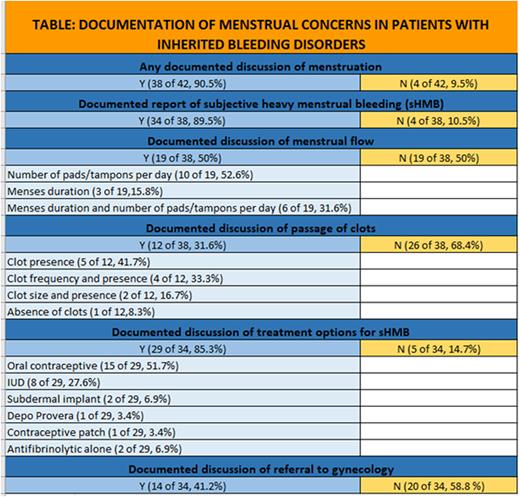Abstract
Introduction:
Inherited bleeding disorders (IBD) such as von Willebrand disease (VWD) and clotting factor deficiencies may be associated with heavy menstrual bleeding (HMB) in patients with a uterus. Identification of HMB and development of an adequate management plan is fundamental to the care of these patients. However, the frequency with which hematologists discuss, document, and recommend treatment or gynecologic (GYN) consultation in women with IBD has not been well described. In this retrospective review, our aim was to assess the frequency and breadth of documented discussions about menstrual concerns in women with IBD during initial consultative visits with a hematologist.
Methods:
We performed a retrospective chart review of women ages 18 to 50 with a confirmed diagnosis of VWD, hemophilia A or hemophilia B seen for an initial consultative visit at the Penn Comprehensive Hemophilia and Thrombosis Program (PCHP) between January 2017 and July 2022. We collected information regarding patient demographics and laboratory values related to the bleeding disorder diagnosis and the frequency of documentation of menstrual periods in general, as well as specific rates of discussion of concerns related to HMB (passage of clots, amount of flow), documentation of management recommendations (oral contraceptive, IUD, adjunctive antifibrinolytic agents) and/or referral to GYN.
Results:
Forty-two patients were included in the analysis including 39 (92.8%) with VWD, 2 (4.8%) with hemophilia A, and 1 (2.4%) with hemophilia B). Thirty-eight of 42 patients (90.5%) had a documented discussion regarding menstrual periods at the time of the initial consultative visit. Thirty-four of the 38 (89.5%) who had a documented discussion about menstruation subjectively reported having "heavy menstrual bleeding" (sHMB), although the quantity was not documented in any case with a verified tool such as the PBAC.
Nineteen of 38 (50%) patients had a documented discussion regarding the amount of menstrual blood flow. Ten (52.6%) had documentation of the number of pads/tampons/products used per day. Three (15.8%) had documented menses duration (number of period days). Six (31.6%) had documentation both of period duration and the number of pads/tampons used per day. Male hematologists documented amount of flow in 41.7% of patient visits, while female hematologists did so for 53.3% of visits.
Twelve of 38 (31.6%) patients had a documented discussion regarding passage of clots during their periods. Five (41.7%) had a description only of clot presence, 4 (33.3%) of clot frequency and presence and 2 (16.7%) of clot size and presence; 1 (8.3%) reported no clot passage. Male hematologists documented the presence of clots for 33.3% of visits, while female hematologists did so 26.7% of visits.
There was a documented discussion of treatment options in 29 of 34 patients reporting sHMB (85.3%). Treatment options included either those in use at the time of the initial consult visit or those recommended during the initial visit in patients who reported inadequate control of sHMB with prior treatments. Treatments discussed included: 15 oral contraceptives (51.7%), 8 IUD (27.6%), 2 subdermal implant (Nexplanon) (6.9%), 1 Depo Provera (3.4%), 1 contraceptive patch (3.4%), and 2 who reported not having any response to hormonal contraception and were treated with antifibrinolytic therapy alone (6.9%). There was a documented discussion of referral to GYN in 14 of 34 (41.2%) of patients who reported sHMB.
Conclusions:
In this retrospective study, we found that hematologists often document menstrual bleeding concerns in female patients with IBD, but do not consistently document specific components of sHMB such as amount of menstrual blood flow and/or passage of clots. Documentation rates were similar for hematologists of both sexes. Standardized templates for evaluation of HMB (both subjectively reported and formally assessed) may improve documentation rates in the future.
Disclosures
Pishko:Sanofi Genzyme: Research Funding; Biomarin: Other: Advisory Board.
Author notes
Asterisk with author names denotes non-ASH members.


This feature is available to Subscribers Only
Sign In or Create an Account Close Modal